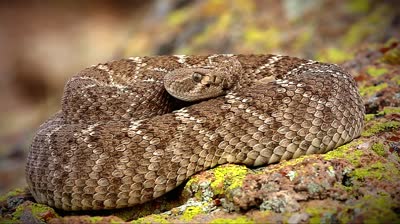Rattlesnake
Category: Snakes

Facts about Rattlesnakes. Scientific name for Rattlesnake is Crotalus and Sistrurus. The Rattlesnake is a member of a group of poisonous snakes of the Crotalus and Sistrurus types that comes from the Viperidae family. The Rattlesnakes are native to America, varying from the southern parts of Alberta and the southern parts of British Columbia in Canada to the Central parts of Argentina. A Rattlesnake is a predator that lives in an extensive collection of homes, hunting small creatures, such as rodents and birds. They slaughter their prey with a poisonous bite, rather than by contracting. The rattlesnake has a set of fangs through which it injects huge quantities of hemotoxic poison. They are mostly associated with dry and desert rock-strewn areas, but they can also be seen on prairies, forests and swampy habitats.
Features of Rattlesnake
A Rattlesnake is an effortlessly recognized animal. The size of a Rattlesnake counts on the varieties. The largest variety of Rattlesnake can attain a body length of 8 feet (2.4 meters). The smallest snake will have a body length between 3 feet (1 meter) and 4 feet (1.21 meters).
The Rattlesnakes are not extremely colorful as they like to conceal with their atmosphere. Usually, they have a brown, black, grey or olive color body. Their head is triangular in shape, with vertical pupils. The Rattlesnake got their name from a rattle on the last part of their tail, which is made of keratin that grows incessantly. A new part is added every time snake drop its skin, usually two times per year. The rattling sound of the snake notifies predator to avoid the snake. When the Rattlesnake is shocked, it can attack devoid of making the rattling sound.
Rattlesnakes are poisonous snakes and they create extremely strong hemotoxic poison. The snake uses this poison for hunting and for protection against predators. Occasionally, these snakes bite without discharging the poison. A few snakes are resistant to the poison of rattlesnakes. Due to that feature, king snakes are major killers of rattlesnakes.
The Rattlesnake has a unique kind of thermal receptor that is used for the recognition of warm-blooded individuals to prey. The Rattlesnake can also find prey by using their tongue that collects smell molecules from the air. Furthermore, the Rattlesnake variety detects the vibration of the ground. The best temperature for the survival of these snakes ranges from 27 degrees Celsius (80 degrees Fahrenheit) to 32 degrees Celsius (90 degrees Fahrenheit). They can stay alive at freezing temperatures, but temperatures more than 38 degrees are serious for them.
The Rattlesnake hides during the freezing time of the year. Generally, a huge number of rattlesnakes assembles in the underground dens and coil around each other for the warming purpose. The Rattlesnake are habitually associated with dry homes, but they can live equally close to the water. These snakes are outstanding swimmers, too.
Diet of Rattlesnake
The Rattlesnake is carnivorous and it usually feeds on mice, rats, and small birds.
Reproduction of Rattlesnake
Generally, a Rattlesnake takes numerous years to attain the sexual maturity, and the female snakes usually reproduce once in three years only. The mating season of rattlesnakes commences during the summer, spring and autumn seasons, according to the varieties. The female snake will give birth to 8 to 10 juvenile snakes. A juvenile Rattlesnake is equipped with strong poison and they can be even more hazardous than mature snakes.
The lifespan of the Rattlesnake depends upon the varieties. Generally, their average lifespan ranges from 15 years to 30 years.

 Back To Category Snakes
Back To Category Snakes